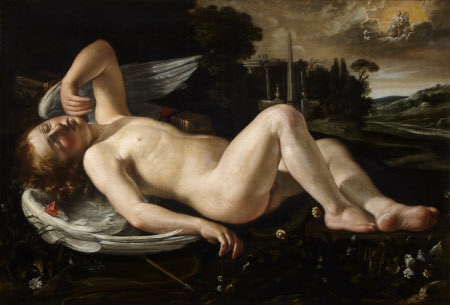Cupid asleep approached by Venus in her Chariot
Orazio Riminaldi (Pisa 1586 – Pisa 1630)
Category
Art / Oil paintings
Date
circa 1628 - 1630
Materials
Oil on canvas
Measurements
840 x 1145 mm
Place of origin
Italy
Order this imageCollection
Kedleston Hall, Derbyshire
NT 108831
Summary
Oil painting on canvas, Cupid asleep approached by Venus in her Chariot by Orazio Riminaldi (Pisa 1586 – Pisa 1630), circa 1628-30. Winged Cupid, as a blind-folded young boy, is stretched out, full length, lying horizontally, head to left, naked on the grass, cradled in his wings, his right knee raised, and his left hand raised and touching his cheek. Venus, in her chariot can be seen descending through the clouds in the distance, on the right and some classical buildings in background on the left. Formerly attributed to Guido Reni, and then to Sisto Badalocchio, this would appear to be instead by the Tuscan Caravaggesque, Riminaldi, who seems to have made something of a speciality of naked Cupids. Engraved as after a Guido Reni by Carlo Fauccii in 1763 (NT 110026).
Full description
This painting of Cupid asleep in a landscape is loosely inspired by ‘Sleeping Cupid’ by Caravaggio (Galleria Palatina, Palazzo Pitti, Florence) painted in Malta in 1608 and recorded in Florence a year later. Although it shares the sculptural qualities of Caravaggio’s painting – and in particular, the accentuated lighting effects used to describe form – Riminaldi’s Cupid rests in a different pose entirely. The sensual and naturalistic portrayal of Cupid’s body suggests that the artist used a live model – as was Caravaggio’s own practice – but the juxtaposition of the figure with the classicising landscape is incongruous, as is the airborne chariot of Venus visible in the distance. It is precisely the lack of specificity in time and place that lends Caravaggio’s ‘Sleeping Cupid’ such expressive force, and Riminaldi’s idyllic setting only serves to dilute the power of the image and the underlying message within. Cupid sleeping can be read as a symbol that love is blind, and this is made all the more explicit here by Cupid wearing a blindfold. The theme had been taken up in 1603 by the Genoese poet Gaspare Murtola (about 1570-1624), in a madrigal written about a painting by Caravaggio (considered lost) which showed Cupid both asleep and blind. The moral overtones of thus motif were elaborated by artists in the early part of the seventeenth century, the implication being that virtuous (sacred) love is all-seeing while erotic (profane) love, is represented by Venus and Cupid, as blind. The painting’s early history in Florence, where it is recorded in the collection of Marchese Andrea Gerini, a member of the prominent Florentine banking family and an amateur pastellist, is testament to the subject’s popularity in that city. The presence in Florence of Caravaggio’s ‘Sleeping Cupid’, conspicuously publicised on the façade of its owner’s palazzo must have inspired seventeenth-century Tuscan artists to produce imitations and variations on the theme. ‘Cupid Asleep in a Landscape’ has been variously attributed to the Emilian painters Guido Reni and Sisto Badalocchio, and the Tuscan Orazio Gentileschi and Orazio Riminaldi, both of whom came from Pisa. The misattribution of the painting to Guido Reni in the mid-eighteenth century is not altogether surprising given the artist’s reputation at that time, and it persisted for over a century. The picture’s classicising tendencies would have appealed to English buyers such as Sir Nathaniel Curzon, for whom the dealer-collector William Kent acquired the painting. Travelling to Italy in 1758-60 to acquire pictures for Curzon, Kent gained access to the Arnaldi and Gerini collections in Florence, and it was in the latter that ‘Cupid Asleep’ was engraved by Carlo Faucci. The English carved and gilt wood frame was probably made for the painting when it entered the collection at Kedleston Hall, as part of Robert Adam’s redecoration scheme. Text adapted from Letizia Treves, Beyond Caravaggio, exh. cat. 2016
Provenance
Collection of the Marchese Andrea Gerini (1696 - 1766), Florence; bought in 1758 by the dealer, William Kent (fl. 1742 - 1761) in Italy, for Sir Nathaniel Curzon as by Guido Reni - engraved by Carlo Faucci in 1763 - thence by descent; bought with part of the contents of Kedleston with the aid of the National Heritage Memorial Fund (NHMF) in 1987 when the house and park were given to the National Trust by Francis Curzon, 3rd Viscount Scarsdale (1924-2000)
Credit line
Kedleston Hall, The Scarsdale Collection (acquired with the help of the National Heritage Memorial Fund and transferred to The National Trust in 1987)
Makers and roles
Orazio Riminaldi (Pisa 1586 – Pisa 1630), artist previously catalogued as attributed to Guido Reni (Bologna 1575 – Bologna 1642), artist previously catalogued as attributed to Sisto Badalocchio (Parma 1585 - 1647), artist Elisabetta Sirani (Bologna 1638 - Bologna 1665), artist
Exhibition history
Beyond Caravaggio, National Gallery, London, 2016 - 2017 Beyond Caravaggio, National Gallery of Ireland, Dublin, 2016 - 2017 Beyond Caravaggio, National Gallery of Scotland, Edinburgh, 2016 - 2017
References
Walpole 1927-28 Paget Toynbee (ed.), 'Horace Walpole's Journals of Visits to Country Seats, etc.', 1760-62, Walpole Society XVI, 1927 -28 pp. 9-80, p.64: “xxxiii …Sept 2d 1768…Kedleston in Derbyshire. Lord Scarsdale’s. … In the Saloon, a fine room….Sleeping Cupid, Elizabeth Sirani..” Pepper 1972 D.Stephen Pepper, 'Caravaggio riveduto e corretto: la Mostra de Cleveland'. Arte Illustrata, March 1972, pp. 170-1, 175, 178, fig.9 Nicolson 1979 Benedict Nicolson, The International Caravaggesque Movement, Oxford, 1979, p. 52 Carafano 2005 P. Carafano, Luce e ombra, Caravaggismo nella pittura toscana del Seicento, Pontedera, 2005 Beyond Caravaggio (by Letizia Treves), The National Gallery, London: 12 October 2016- 15 January 2017; National Gallery of Ireland, Dublin, 11 February - 14 May 2017; Scottish National Gallery, Edinburgh, 17 June - 24 September 2017, cat.25, pp.110-111 Harris 1978 Leslie Harris, 'The Picture Collection at Kedleston Hall', The Connoisseur, July 1978, vol.198, no.79, pp. 208- 218


